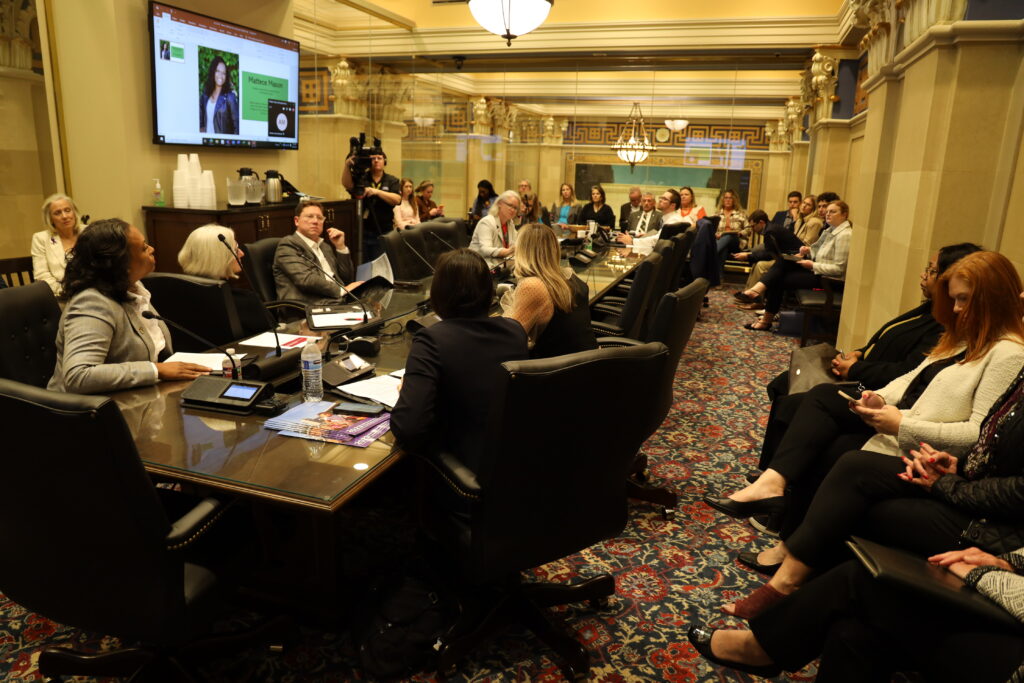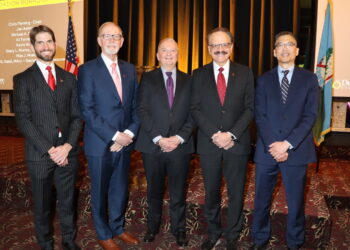OKLAHOMA CITY (OBV) – An interim study led by Rep. Suzanne Schreiber explored a crisis situation affecting parents across Oklahoma as well as the state’s workforce and business community: lack of accessible and affordable childcare.

The interim study was held on the fifth floor of the State Capitol. Childcare experts from across the state participated in the interim study, which not only explored the childcare crisis, but also considered possible solutions.
“Everybody needs childcare. That’s why it needs to be strengthened,” Schreiber, D-Tulsa, said.
Carrie Williams, executive director of Oklahoma Partnership for School Readiness, spoke during the interim study, saying that 1 in 10 Oklahomans have had to either quit their job, change jobs or turn down a job because they could not obtain or afford childcare.
“Oklahoma faces a critical shortage of quality childcare across the state,” Williams said.
Williams said the crisis costs Oklahoma $1.2 billion annually in lost earnings.
Mattece Mason, who owns Jewel’s Place, a childcare center in Tulsa, shared her insight into the childcare struggle. She started a family childcare home in 2022. She said she fell in love with the children she cared for and became dedicated to their care.
“No sector of business can function without childcare,” Mason said. “[The childcare crisis] is a frightening reality we must face, but together we can rise to the challenge.”
Schreiber has been a stalwart proponent of childcare reform. She authored House Bill 2452, which succeeded in the Oklahoma Legislature this past Spring and was signed into law by Gov. Kevin Stitt. The bill streamlines Oklahoma’s family childcare home licensing regulations to help daycares and other such facilities stay open, which ensures greater childcare availability for Oklahomans. It was a key bill in the legislative effort to expand childcare and get more parents back into the state’s workforce.
Obtaining childcare, affordable childcare especially, has been an ongoing challenge for Oklahoma parents, with many having to quit their job to stay home and take care of their child.
“Thirty-four of Oklahoma’s 77 counties are considered childcare deserts, meaning more than 55 percent of the state does not have access to a childcare facility,” Oklahoma House Democratic Caucus officials said.
Childcare facilities have been on the decline in Oklahoma for more than a decade.
Oklahoma had more than 4,000 facilities in 2012; that number dwindled to 2,954 by 2021, a more than 25 percent drop.
Williams told Oklahoma Business Voice in April that long childcare waiting lists prevent many parents from getting their child into a facility.
“The wait list for childcare can be up to two years for an infant. So, they’re not an infant anymore by the time the parents can obtain childcare,” she said.

Oklahoma businesses have been adversely impacted by the childcare facility and worker shortage, seeing a 6.1 percent decline in workforce labor participation among Oklahoma mothers who have children ranging in age from infant to four years old. It’s a problem impacting businesses across the board.
“It’s in every sector. It’s [happening] at a very high, professional level and it’s at the manufacturing level – it’s at that kind of a hands on level,” Schreiber said. “We need all of those people to grow Oklahoma’s economy.”
Parents nationwide are exiting the workforce due to diminishing childcare options.
Anyone who hasn’t noticed that the workforce is directly connected to childcare must wake up, because that is a fact,” said. Rep. Brian Hill, R-Mustang, who asked questions to the childcare experts during the study.
A U.S. Chamber of Commerce Foundation study states that 58 percent of working parents reported leaving their job because they could not find viable childcare. Also, 32 percent of women surveyed said having to be home to care for family members made returning to work difficult.
Mothers are especially impacted, quitting work at an alarmingly high rate to stay home and take care of young children. The labor participation rate among Oklahoma mothers with children ranging from infant to four years old declined 6.1 percent between 2020 and 2021.
Rep. Ellyn Hefner, D-Oklahoma City, participated in the study and asked the childcare experts if they had any data on how leaving the workforce again and again would impact the retirement funds, such as 401Ks, of mothers who have to stay home and take care of their children. Aaron Merchen, director Policy and Programs for the U.S. Chamber of Commerce Foundation’s Center for Education and Workforce, participated in the study, providing insight into the national childcare crisis. He told Hefner his group within the U.S. Chamber is looking into the impact on retirement plans but final data is not yet available.
The childcare shortage is not only causing parents to leave their job, it’s also preventing them from returning to work.
“Dropping out of the workforce to care for children greatly disadvantages women, often in the form of lower wages and missed promotions,” the U.S. Chamber report states.
Childcare breakdowns cause states to lose an average of $1 billion in economic activity annually, according to the foundation study. Part of the lost revenue stems from the cost of parents missing work because quality childcare was not available—or unaffordable.
The average cost of childcare in the U.S. ranges from $11,000 to $29,000 annually, according to the U.S. Chamber.
Kim Wilmes, vice president of Economic Development Program for the Greater Oklahoma City Chamber, participated in the study, saying that Oklahoma City is feeling the economic brunt of limited childcare availability.
“Inadequate access to quality childcare negatively impacts Oklahoma City’s economy and prevents people from joining the workforce, earning a living for their families, and buying business services,” Wilmes said. “And it causes employers a problem with getting their work done and finding people who generate revenue.”
Oklahoma parents who manage to find a childcare facility nearby often have to contend with high childcare costs. Oklahoma is one of the 10 most expensive states for childcare costs, with families having spent 6.9 percent of their income on childcare in 2020.
The childcare crisis is a national epidemic. Businesses across the nation are losing employees because of childcare shortages. Childcare system gaps prevent businesses from fully re-staffing their operations, which leads to closures and operation hour reductions across all industries. The Foundation study states that employee absences and turnover costs employers anywhere from $400 million to $3 billion a year.
The state has relied on funds from childcare desert grants as well as stabilization grants to help Oklahoma childcare centers and incentivize the opening of new centers.
Subsidized childcare aid provided through a federal Childcare Development Fund grant is helping low-income Oklahoma families reenter the workforce. It also aids individuals working in the childcare field.
The state has also used ARPA funds to alleviate the childcare crisis.
“We are exceptionally grateful for these funds, but the fact of the matter is, they barely got us to square one,” Mason said.
Although childcare is a national crisis, it must be addressed on a local level, Merchen said.
“It’s really going to take parents, providers, state and local businesses, state and local policymakers to figure out what is the best way to make sure that kids are getting the attention that they need, and that working parents are able to not just participate but thrive in the workforce,” Merchen said.
The state can alleviate childcare burdens by giving tax incentives to businesses that provide childcare in the workplace.
“So when we think about childcare from the employer perspective, again, if the employee doesn’t have childcare, they’re not going to come to work, and we’re losing so many people in that realm,” Schreiber said. “So, employer’s thinking about whether or not they are going to offer this is a benefit. The state can incentivize that by offering tax credit to those employers for whatever they offer to share with their employee in cost of childcare. We have almost 50-60 percent working parents today that have a child under five.”
Oklahoma must continually work to support and fortify childcare facilities, Schreiber said.
“Just like we stimulate other industries – nursing, aerospace, manufacturing, tech – we need to stimulate the childcare industry as well, because none of those other things actually work when we don’t have the childcare industry,” Schreiber said. “It doesn’t matter how much incentive we put into recruiting an employer if those employers don’t have the workers they need because the workers don’t have childcare.”

















